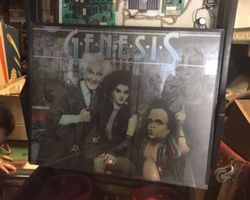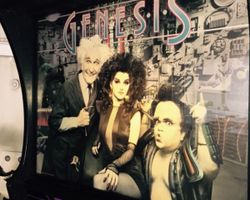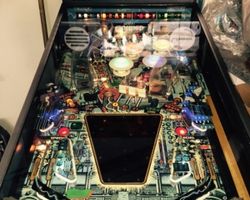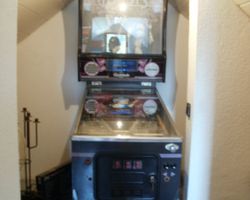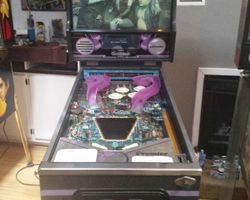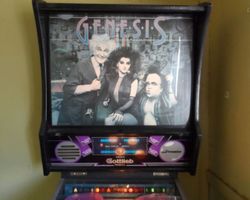Genesis
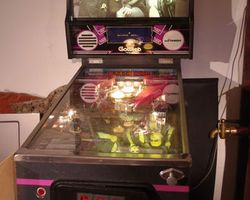
Average Prices: USD $200 to $800
Produced: September, 1986
Production Run: 3,500 units
Machine Type: Solid State Electronic
MPU: Gottlieb System 80B
Players: 4
Concept by: John Trudeau
Design by: John Trudeau
Art by: Larry Day, Don Marshall, Ken Hale
Software by: John Buras
Pinball machines often embody the creative spirit of their era, and the 1986 "Genesis" by D. Gottlieb & Co., under its Premier Technology brand, stands as a prime example of mid-1980s design ambition. This solid-state electronic (SS) machine, designated Model 705, emerged during a period of transition in the pinball industry, where manufacturers sought to captivate players with innovative concepts and advanced mechanics. Production of "Genesis" totaled 3,500 units, a respectable run for its time, solidifying its presence in arcades and homes.
History and Background
The conceptual genesis of "Genesis" lies in a blend of classic science fiction and cinematic inspiration. Designer John Trudeau drew heavily from the visual and thematic elements of Fritz Lang’s 1927 German expressionist film, 'Metropolis,' particularly its depiction of creating an artificial human. This inspiration provided a fertile ground for "Genesis"'s unique narrative: the player's objective to assemble a new life form.
The design and production process for "Genesis" involved a dedicated team. John Trudeau not only conceived the game's core concept but also meticulously designed its playfield. The visual identity of the machine was a collaborative effort; Larry Day was responsible for the detailed artwork found on the playfield and cabinet, setting the thematic atmosphere. The distinctive black-and-white photographic translite was the work of Don Marshall, who also designed the accompanying brochures and advertisements. Ken Hale later added a subtle layer of color to Marshall’s translite using photo oils, enhancing its visual appeal. Ken Hale further contributed to the machine's auditory landscape, composing both the music and sound effects that defined its gameplay experience. John Buras handled the software, bringing the game's rules and features to life on the Gottlieb System 80B MPU, a robust platform for its time. Released on September 9th, 1986, "Genesis" represented a concerted effort to deliver a compelling pinball experience rooted in a compelling sci-fi fantasy theme.
Signature Features and Design
"Genesis" distinguishes itself with several notable elements that enhance both its gameplay and thematic depth. Central to the machine's allure is the "Regenerator" mechanism, a unique animated feature positioned under a dark-tinted window in the middle of the playfield. This "Regenerator" houses the "Lifeforce," the machine's primary interactive toy. When the "Lifeforce" is activated, a full-stroke shot on the vari-target triggers an unveiling sequence. This moment is accompanied by a dynamic light show, with flashers illuminating the robot and emanating from behind the translite, synchronized with a musical passage from Bach's 'Toccata and Fugue in D Minor,' a piece famously used in Gottlieb's 1982 machine 'Haunted House.' This dramatic reveal of the Lifeforce robot serves as a focal point, drawing players into the machine's narrative of creation.
Beyond the Regenerator, "Genesis" incorporates two ramps, two kicking targets, and a vari-target. The vari-target, a mechanism that registers different scores or triggers different events based on the force of the ball's impact, is strategically placed and integral to initiating the "Lifeforce" sequence. The machine also features two flippers, four pop bumpers, two slingshots, a three-bank of drop targets, a kick-out hole, and a single captive ball, all contributing to a varied and engaging playfield. The overall aesthetic of the playfield, with its sci-fi and robot motifs, is further enhanced by its vibrant lighting, which is particularly effective during key game events such as multiball, where a full light show immerses the player.
Playfield and Mechanics
The playfield of "Genesis" is designed for speed and flow, characteristic of John Trudeau's approach, yet it incorporates distinct features that demand precision. The layout includes two prominent ramps that offer opportunities for continuous ball movement and shot combinations. A key objective for players is to complete the letters of body parts — ARMS, LEGS, BODY, BRAIN — which are lit by hitting specific targets and activating sequences.
Major shots include the two ramps, providing satisfying returns to the flippers for continued play, and the shot to the vari-target, which is critical for advancing the "Lifeforce" objective. The three-bank of drop targets presents a direct challenge, often guarding a specific scoring opportunity or mode progression. Two kicking targets on the playfield provide unpredictable ball redirection, adding an element of challenge and surprise. Four pop bumpers are positioned strategically to create a chaotic, high-scoring zone in the upper playfield, feeding balls back into play with force. The single captive ball adds another target for skill shots, allowing players to build score multipliers or activate features through repeated hits.
The playfield artwork, executed by Larry Day, visually reinforces the machine's theme. Mechanical components are seamlessly integrated into the sci-fi landscape, with pathways and targets delineated clearly. The lighting design works in concert with the artwork, using flashes and sequences to guide the player's focus and celebrate achievements, particularly during the "Lifeforce" activation and multiball. This synergy between physical layout, artwork, and lighting contributes to a cohesive and immersive experience.
Gameplay Dynamics
"Genesis" operates on a progressive scoring system that rewards players for understanding its core mechanics and objectives. The primary goal centers on activating the "Lifeforce" robot. Players advance towards this by hitting the vari-target, which not only contributes to the reveal sequence but also often carries significant point values depending on its full-stroke activation. The game employs a 2-ball multiball, triggered through specific shot combinations or objectives, which dramatically increases scoring potential and offers a period of intense, fast-paced action.
A central gameplay objective involves spelling out the words for various body parts: ARMS, LEGS, BODY, and BRAIN. Achieving these spell-outs often lights up specific playfield features, grants bonus points, or advances the player towards the ultimate goal of completing the robot. The game offers skill shots, providing an immediate opportunity to earn bonus points or advantages at the start of each ball. Successfully navigating the two ramps is crucial, as they can lead to significant points or access to various game modes. The drop targets also play a role in progression, often opening up new pathways or lighting features upon completion.
Player strategies in "Genesis" often revolve around consistently hitting the vari-target to progress the "Lifeforce" sequence while also managing the multiball to maximize scoring. The fast flow, driven by well-placed pop bumpers and return ramps, means players must maintain control and react quickly. The engaging synth-heavy soundtrack, composed by Ken Hale, complements the gameplay, intensifying during multiball or the "Regenerator" reveal, creating a memorable audio-visual experience that compels players to continue.
Reception and Legacy
"Genesis" generally holds a positive reputation within the pinball community, often described as an underrated machine that offers strong value. Its core gameplay is frequently praised for being simple to grasp, yet challenging to master, fostering an addictive "one more game" appeal. The flow of the playfield and the speed of the action are often highlighted as strengths, contributing to an engaging experience. The progressive scoring system, particularly the ability to build multipliers, is seen as a key factor in its replayability and high-score potential.
The "Regenerator" and "Lifeforce" robot reveal sequence is consistently cited as a standout feature, praised for its unique mechanical design, the dramatic lighting effects, and the satisfying culmination of efforts. The vari-target is also highly regarded for its integral role in gameplay. Ken Hale's music and sound design are frequently commended for being catchy, fitting the 1980s electronic aesthetic, and enhancing the thematic atmosphere. The playfield artwork by Larry Day is generally considered well-executed and appropriate for the theme.
However, "Genesis" is not without its common criticisms. The translite artwork, a black-and-white photograph tinted with photo oils by Don Marshall and Ken Hale, is frequently the subject of mixed opinions, with some players finding it less appealing than the playfield art. Similarly, the cabinet artwork is sometimes described as understated. Some players have noted the "lollipop purple" color of the factory ramps as a less visually appealing choice, and concerns about ramp durability or engineering issues, such as balls hitting the glass or difficult shots, have also been mentioned. The alphanumeric display's small font size for scoring is another minor point of feedback. While lacking speech, many players feel this omission does not detract from the game's overall quality.
Despite these points of feedback, "Genesis" maintains its standing as a fun, fast, and challenging game. Its unique "building a robot" theme, distinct mechanical features, and strong audio package contribute to its enduring appeal. As a product of the Gottlieb System 80B era, it demonstrated the potential for deep gameplay within that platform, and its blend of thematic ambition with accessible rules has ensured its continued appreciation among enthusiasts looking for a compelling and affordable pinball experience.
Sponsored Links
 Ebay Listings
Ebay Listings
 Auction Results
Auction Results
| Cost | Location | Date |
|---|---|---|
| USD $2,700 |  Utah, United States Utah, United States |
05 March, 2025 |
| USD $2,195 |  California, United States California, United States |
11 March, 2021 |
| USD $900 |  Maine, United States Maine, United States |
14 February, 2019 |
| EUR €1,299 |  Nordrhein-Westfalen, Germany Nordrhein-Westfalen, Germany |
30 December, 2018 |
| USD $1,300 |  Ohio, United States Ohio, United States |
16 December, 2018 |
| USD $750 |  Wisconsin, United States Wisconsin, United States |
25 May, 2018 |
| USD $625 |  Illinois, United States Illinois, United States |
30 April, 2018 |
| USD $1,100 |  Michigan, United States Michigan, United States |
20 November, 2017 |
| USD $1,100 |  Pennsylvania, United States Pennsylvania, United States |
31 October, 2017 |
| USD $1,890 |  Idaho, United States Idaho, United States |
20 June, 2016 |


Private Policy · Search Website · Contact Us
As an eBay Partner, we may earn a commission from qualifying purchases made through links on this site, at no additional cost to you.
All trademarks and copyrighted materials remain property of their respective owners. All other content copyright 2007 - 2025 Pinpedia.

